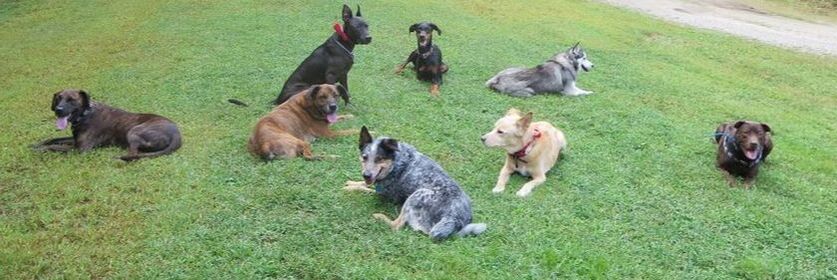
Uses for This Exercise: Great for keeping a dog stationary when doing chores around the house. Stationing a dog in any human or canine social environment when needed. To keep the dog from greeting too enthusiastically by learning to wait and greet when allowed. By staying in a reliable stationary command, the dog will not be able to perform that and jump on someone. This command teaches impulse control and observation of the environment and triggers in the safe supervision of their owners.
What is one successful way to start a stay command?
Recommended tools to start: 6' Leather Leash (puppies or very small dogs can be on a lessor quality leash), Training Collar (slip, well fitted flat collar, martingale, metal chain training collar), Treats (optional and mostly for puppies or dogs having a really hard time)
Recommended environment to start: Low distraction generally indoor environment to start. Not much room is needed to start this exercise.
Perquisites: A down, sit, or stand exercise should be taught first. Just a sit exercise will do just fine to start.
STEP 1: Start with the "sit" command.
STEP 2: If you like you can start have "sit" mean stay, or you can use an additional "stay" command (totally owner's preference).
NOTE: USING YOUR MARKER WORDS AND LURING THE PUPPY WITH A TREAT IS BETTER THAN REPEATING THE COMMAND. ONLY SAY THE COMMAND ONCE, THEN SAY NO (FOR THAT IS NOT WHAT I WANT), AND THEN TRY LURING WITH A TREAT. SHOULD THAT NOT WORK MOLDING IS ALSO ACCEPTABLE. IT MAY ALSO BE THAT YOU HAVE PICKED A TIME WHERE THE PUPPY IS TIRED, SO REMEMBER TO ONLY TRAIN A PUPPY THAT IS AWAKE AND IDEALLY WILL TAKE FOOD REWARDS.
STEP 3: When you begin, you may just wish to start with 5 seconds or so. You will be standing by the puppy, and you want the puppy to stay in the sit command during this time. You can tell if you are doing too much time if getting a few in a row is very difficult (IE the puppy gets up, slumps into a down, gets distracted).
STEP 4: If the puppy is successful, give them their food reward and then the release word "break".
STEP 5: Repeat 10-15 times. (eventually we want to get up to 30 seconds or 1 minute, which is usually dependent upon the puppy's ability).
Goal: Is to get four in a row without verbal marker correction or molding (eventually without treats until the fourth one, but that is not necessarily a week 1 goal) at least four times in a row each session. Bonus points if you can get 3 sets of four in a row. As I go beyond the 30 second mark, I would just get four in a row in one session.
STEP 1: Give the sit command in either heel position or randomly (in other words dog is walking not in heel position).
STEP 2: Give the verbal stay command (if you are going to be competing be sure to give the hand gesture too in front of their face) NOTE: SOME PEOPLE USE SIT AS THE CUE TO STAY UNTIL RELEASE WORD, WHICH IS OKAY. IN COMPETITION YOU MUST SAY STAY. SOME PEOPLE JUST FEEL MORE COMFORTABLE SAYING STAY, SO THIS IS USUALLY THE WAY THAT I TEACH IT.
STEP 3: The handler/owner will remain by the dogs side. I start the dogs off (if they are truly green) as low as five seconds to fifteen seconds at first. When they are staying there consistently four out of five times for the duration, I start moving the duration up from 5 additional seconds to as much as 30 additional seconds depending on the dog.
STEP 4A: If the dog attempts to get up, there are a few ways to save the command. (1) You can step out quickly in front of them, then walks towards them if their butt didn't entirely come off. This usually makes the dog sit back down. (2) If you time the sit correction right so that they catch themselves and sit down before lifting the butt all the way up, or they may themselves sit back down before their butt gets up (if you have given the correction consistently and well timed before). NOTE: IF THEY CORRECT THEMSELVES DURING THE EXERCISE, THIS CAN BE COUNTED AS A SUCCESSFUL REPETITION IN THE SPIRIT OF THE FOUR OUT OF FIVE RULE. IF THE DOG DOES NOT STAY IN POSITION OR DOES NOT CORRECT THEMSELVES, THIS WAS NOT A SUCCESSFUL REPETITION.
STEP 4B: If your dog was successful by staying in place OR self correcting themselves (this is an important learning step for the dog), then praise with a "good girl/boy" and a low key pat (unless your dog needs the higher praise because they are shy or fearful, and not likely to become unglued due to the stimulation).
STEP 5: Give your dog the release word. (be sure that good girl/boy or a treat does not ever become the cue to release)
STEP 6: Do each repetition 15 times. DO NOT increase the duration until your dog can successfully do them four out of five times at the old duration. You want to build this exercise up to one minute before going on to the next step.
 RSS Feed
RSS Feed